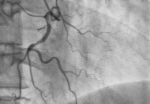Aspiration thrombectomy (AT) in patients with high thrombotic burden could pathophysiologically reduce thrombus burden, decrease distal embolization, reduce no-reflow phenomenon, and improve microvascular perfusion. However, its usefulness has not been shown in the large, randomized trials (TASTE and TOTAL) that compared routine use of AT in primary angioplasty in patients with ST-segment elevation acute coronary...
The Best of SOLACI-SOCIME 2022 Main Arena – Chronic Total Occlusions (CTO)
How to Choose the Best Approach in Chronic Total Occlusions, by Dr. Jean-Michel Paradis CTO are present in around 16 to 20% of patients with coronary artery disease who get a coronary angiography. CTO Percutaneous intervention has been on the rise, mainly due to equipment and technique advancement. During his presentation, Dr. Paradis mentioned the...
CTO: Trials vs. Real-World
Percutaneous coronary intervention of chronic total occlusions (CTO) is currently indicated for symptom improvement, as studies have inadequate randomization of data which hinders the assessment of hard outcomes. However, patient inclusion in randomized controlled trials has been challenging, especially for highly symptomatic and higher risk patients. This causes a selection bias in randomized studies on...
Progress-CTO Score: A Key New Tool to Plan CTO
Intervention of chronic total occlusions (CTO) through angioplasty (PCI) can cause complications, even in highly experienced centers. Plenty has been written on the probability of success for the treatment of CTOs using scores such as CL-SCORE, J-CTO, ORA, E-CTO, CASTLE-CTO, etc. (some of which are usually used when preparing these cases). However, besides estimating success...
Changes in Coronary Collateral Function Post CTO Intervention
In the last few years, we have seen significant growth of chronic total occlusion (CTO) percutaneous intervention, which has also been considered for patients with viable territory that remain symptomatic. Experienced centers present successful CTO intervention rates close to 90%, especially with a hybrid approach. However, it is still a complex procedure, and target vessel...
Thromboendarterectomy vs. Endovascular Therapy in Common Femoropopliteal Territory. Is Surgery Still the Gold Standard?
For lesions in the common femoral artery, guidelines recommend surgical endarterectomy (TEA) as the gold standard. However, endovascular therapy (EVT) is an alternative option for these lesions. In 2017 the first randomized study comparing TEA vs EVT was carried out, showing that EVT presents clinical benefits, though it does not replace surgical treatment as first...
EuroPCR 2022 | The IMPROVED-CTO Trial
PCI success rate in chronic total occlusion (CTO), according to some registries, is below 80%. These failed revascularization procedures might lead to quality-of-life deterioration and shorter survival. This concern has driven the development of new techniques and technologies in an attempt to increase PCI success. Today, approximately 20% of CTOs are treated with a second...
EuroPCR 2022 | Galileo Trial: Mortality Predictors after Successful TAVR
Patients undergoing TAVR are mostly older and more fragile, with comorbidities both cardiovascular and non-cardiovascular. Therefore, they are associated with thromboembolic and bleeding risk. This study looked mortality predictors after successful TAVR in the Galileo trial. Mortality at 248 days was 9.2%, 5.5% being of cardiovascular cause and 3.9% non-cardiovascular. Mortality predictors were age >85,...
Transfemoral vs Transradial Approach in the Percutaneous Treatment of CTO
Percutaneous treatment of chronic total occlusion (CTO) has traditionally been via the transfemoral approach (TFA). The use of the transradial approach (TRA) in complex coronary interventions has been increasing. A randomized study assessed the use of TRA vs TFA in complex PCI (58% CTO) and TRA saw favorable outcomes. The aim of this prospective, randomized,...
Is Increased Mitral Valve Gradient After MitraClip a Long-Term Prognostic Factor?
Transcatheter mitral valve repair using the edge-to-edge strategy has become a therapeutic alternative for patients with severe primary mitral valve regurgitation (MVG) who are at high or extreme surgical risk. However, both degree of residual regurgitation and gradient after the procedure should be taken into account, as in previous studies the latter was associated with...








